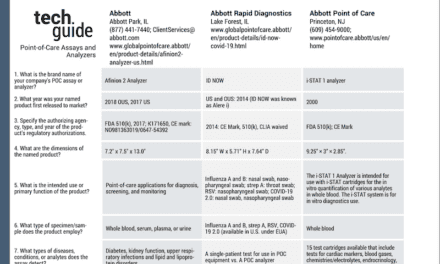In vitro diagnostics manufacturer EKF Diagnostics, Cardiff, Wales, reports that its Quo-Test HbA1c analyzer has shown the capacity to improve the medical management of patients with sight-threatening diabetic retinopathy (STDR). The results were featured in a study by the Great Western Hospital NHS Foundation Trust and presented at the annual congress of the Royal College of Ophthalmologists.1
Diabetic eye disease is a leading cause of sight impairment in working age adults; STDR patients have often been found to have poor knowledge and insight into their diabetic control. The study aimed to evaluate the clinical impact of measuring HbA1c in an ophthalmology outpatient setting in patients with STDR. Using EKF’s Quo-Test to provide rapid HbA1c results from fingerstick blood, the researchers concluded that point-of-care (POC) HbA1c is a useful tool for improving patient education, identifying those with poor diabetic control, and enabling rapid medical referral.
Sunil Mamtora, MD, special registrar in ophthalmology at Great Western Hospital and the study’s lead author, says the feedback has been positive. “Our study showed that POC HbA1c has a huge potential to improve the medical management of patients with diabetic retinopathy. There is also potential for monitoring in clinical trials to further evaluate links between glycemic control and new diabetic eye disease therapies, such as intravitreal injection treatment for diabetic macular edema.”
Mamtora says the Quo-Test analyzer is used routinely “to rapidly assess patients with poor diabetic control, or those who have not had HbA1c measured within the last 6 months, and we are considering referral to a diabetes specialist. If POC HbA1c is over 64 mmol/mol then the diabetes clinic allows us to refer directly to them based on this validated POC result.”
Further benefits of receiving fast turnaround and lab-accurate HbA1c results using Quo-Test were also noted by the study. These included the ability to educate patients with poorly controlled diabetes at the point of care and eliminate the need for follow-up communication or visits. Being able to test, triage, and refer directly to the diabetes clinic from ophthalmology outpatient clinics makes POC HbA1c an ideal screening strategy for rapidly identifying STDR patients who would benefit from intensified diabetes medical management.
For more information, visit EKF Diagnostics.
Reference
- Mamtora S, Hasan H, Guthrie G, Shah N, El-Ashry M.Improving the medical management of patients with sight-threatening diabetic retinopathy. Poster presentation at the annual congress of the Royal College of Ophthalmologists, Glasgow, May 20–23, 2019. Available at: www.ekfdiagnostics.com/res/A0_hb1c.pdf. Accessed September 1, 2019.






